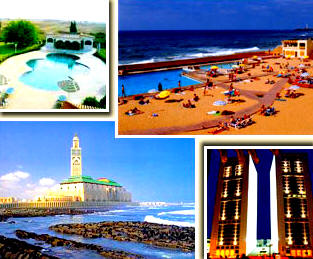 Casablanca Casablanca
Casablanca is by far Morocco’s largest city and the economic and
financial capital
of the country. With 5.5million inhabitants, this
amazing metropolis is the country’s
first business centre, first
port and first university centre. ‘Dar el-Beïda’ (meaning ‘white
house’ – Casa Blanca in Spanish) is a city where skyscrapers stand
in absolute contrast
to the small shops of the medina, a city where
tradition and modernity co-exist.
Hassan II Mosque
Casablanca’s most impressive highlight is the Hassan II Mosque,
which can be seen from almost any point in the city. With a prayer
hall that can accommodate 25.000 people at once, it is the
second-largest religious building in the world after the mosque in
Mecca. The complex covers 9 hectares (968.774 sq ft), two-third of
it being built over the sea. The minaret, the lighthouse of Islam, is 200m (656 ft) high, and two laser
beams reaching over a distance of 30km (18.5 miles) shine in the
direction of Mecca.
The building was designed by Michel
Pinseau, 63.000 craftsmen worked on it, and it opened and 1993. With
carved stucco,
zellij tile work, a painted cedar
ceiling and marble, onyx and travertine cladding, it is a monument
to Moroccan architectural virtuosity. The Hassan II Mosque is the
only mosque in Morocco that can be visited on the inside by
non-Muslims and for touristic purposes.
Old Medina and United Nations Square
At the beginning of the 20th century, Casablanca consisted only of
the old medina, which today still contains 2 of the former 4 gates,
a fortified bastion and the marabout (shrine) with the Tomb of Sidi
Allal El-Kairouani, Casablanca’s first patron saint in 1350.
In a labyrinth of small alleys and limed
houses, you find a daily market with jewellers, handicraft shops, a
food market and counterfeit clothing and bags.On the
Southside of the old Medina is the United Nations Square, built in
1920 by Joseph Marrast and formerly known as ‘La Place de France’.
At the beginning of the 20th century no more than a market square, today it links the old and the new town
with its tramway, banks, hotels, souvenir shops and brewery terraces.
Mohammed V Square
The Mohammed V Square is the location of the Prefecture, ‘Palais de
Justice’ (governor’s house), the central post office,
the French Consulate, banks and cultural
organizations. The buildings, the park and the fountain show scenery
of monumental
French architecture combined with the
Moorish sobriety.
Corniche - Ain Diab
Frequented night and day by the Casablanca people and the tourists,
the Corniche of Ain Diab is a promenade on the seaside
of Casablanca, where swimming pools,
hotels, restaurants and fashionable nightclubs succeed each other.
At the western
end of Ain Diab’s beach is the Marabout
of Sidi Aberrahman, only accessible at low tide and considered
sacred by Muslim pilgrims.
Habous (New Medina)
In the 1930s French town planners laid out a new medina in order to
address the problem of an expanding urban population
and to prevent underprivileged citizens
from being forced to settle in insalubrious quarters. This town was
built in the traditional
Arab style and at the same time obeying
modern town planning and public health regulations. It contains many
small shops
with handicraft objects, flower-filled
and arcaded streets and a former tribunal. On the fringes of the
Habous quarter
is the Royal Palace with its extensive
Mediterranean gardens.
Anfa
Occupying a hill that overlooks Casablanca from the Northwest, Anfa
is a residential quarter with wide flower-lined avenues where luxurious homes with terraces,
swimming pools and lush gardens bring to mind Beverly Hills. Since
the 1930s, villas in a great variety of styles have
been built here, and they constitute a catalogue of successive
architectural styles and fashions.
Rick’s Café
Between Casablanca’s port and the North side of the old Medina, is
the world-famous Rick’s Café. Known as the scenery
of the 1924 movie ‘Casablanca’, it is
today an excellent restaurant that attracts curious travellers from
all over the world
who wish to experience the mythic
ambiance of ‘Casablanca’.
http://www.rickscafe.ma/
Shopping
Twin Center:
Dominated by its two towers, which rise to a height of 100m (328 ft),
this extensive complex is proof and symbol of the city’s economic
importance. Built by Ricardo Bofill and Elie Mouyal, 1 tower
contains a hotel, the other offices, shopping malls and a conference centre. By its outward
appearance no less than in its infrastructure the building signals
the economic role that Casablanca plays on both
the national and
international stage.
Morocco Mall:
At the western end of Ain Diab’s beach Morocco Mall opened its doors
in 2011, one of Africa’s biggest shopping mall with
over 600 brands operating in various
activities, international cuisines and an amazing garden with
musical fountains.
http://www.moroccomall.net/home
Anfa Place:
Located at the Corniche Boulevard at the AnfaPlace Living Resort,
the Anfaplace Shopping Center is the new mall of reference
in Casablanca that opened its doors in
February 2013.
http://www.anfaplace.com/proyecto_eng.html
Weather:
Winter temperature = 5 - 15°C. Summer temperature = 20 – 30°C.
November – February some rainy weeks. High humidity level. Up to 10
hours sun per day.
Festivals:
Jazzablanca April
Official website of the festival:
http://www.jazzablanca.com/
|